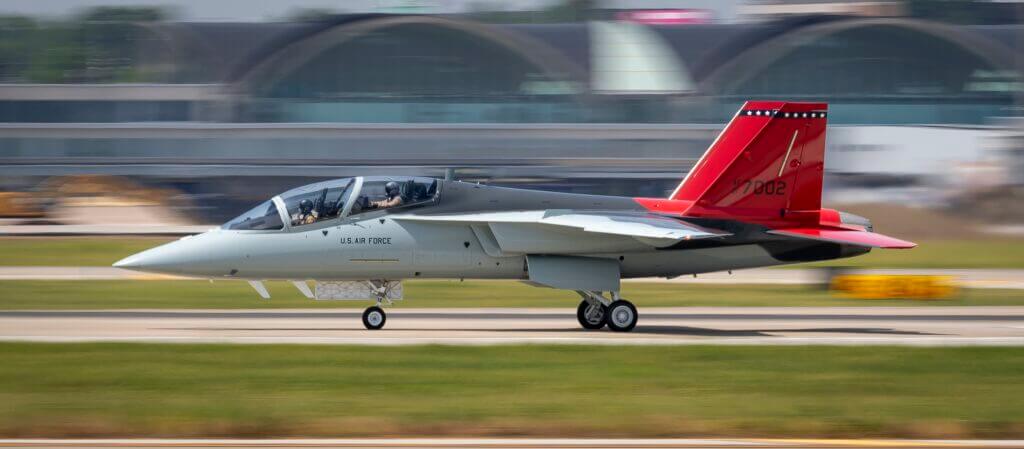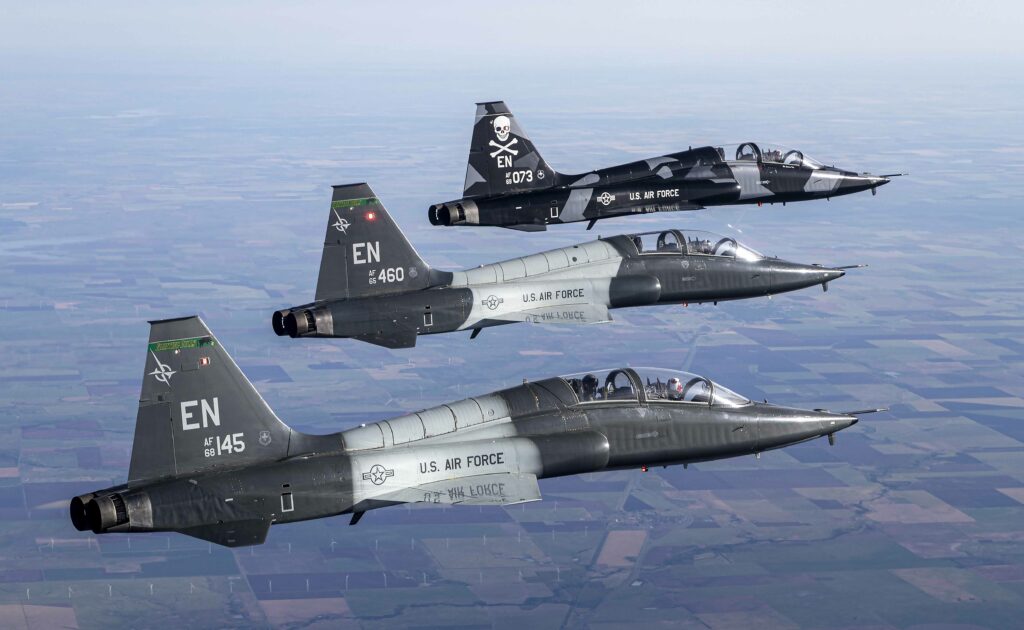Estimated reading time 7 minutes, 33 seconds.
Boeing and the U.S. Air Force (USAF) on June 28 achieved a significant milestone as they completed the first flight of the T-7A Red Hawk advanced trainer aircraft in its production form.
The one hour and three-minute flight, which took place at Boeing’s St. Louis, Missouri, facility, was completed with one of five engineering and manufacturing development (EMD) aircraft, marking the start of the EMD phase of the program. The aircraft is to be delivered to the Air Force Air Education and Training Command for further testing, Boeing said.
Prior to introducing the EMD aircraft, Boeing utilized two demonstrator jets for the T-7A — which first began flight tests in late 2016. The demonstrator jets have since accumulated thousands of flight test hours providing valuable data, though they do not represent the final production configuration of the trainer.

The inaugural flight of the T-7A in its production form comes just over a week after the same EMD aircraft (serial number 21-7002) successfully completed taxi tests. USAF Maj Bryce Turner of the 416th Test Squadron, and Boeing T-7 chief test pilot Steve Schmidt, validated key aspects of the aircraft during the flight.
“The stable performance of the aircraft and its advanced cockpit and systems are game changers for U.S. Air Force student pilots and instructors alike,” said Turner, whose grandfather and father were both USAF fighter pilots. “We’ve come a long way in training since my family role models flew.”
Equipped with open architecture software and digital fly-by-wire controls, the T-7A can support training for a wide range of fighter and bomber pilots. The aircraft’s adaptability enables it to evolve alongside advancing technologies, threats, and training requirements, according to Boeing.
Moreover, the aircraft incorporates an all-new advanced pilot training system, which utilizes high-resolution ground-based training systems and simulators — offering realistic live, virtual, and constructive (LVC) training capabilities.

The T-7A’s maiden flight brings the USAF one step closer to taking delivery of its new advanced jet trainer, which will replace the Air Force’s aging fleet of T-38C Talon aircraft. However, the program has experienced significant delays.
In 2018, Boeing secured a $9.2 billion contract from the Air Force for the production of 351 T-7A advanced trainers, along with 46 simulators and support equipment. While the USAF was initially expecting to take delivery of the first five production aircraft this year, that date has now slipped to late 2025. The trainer is ultimately not anticipated to achieve initial operating capability with the USAF until 2027.
Boeing has touted the fact that the T-7A is “the Air Force’s first advanced trainer to be digitally designed, built and tested.” This means that Boeing used model-based engineering, 3D design, and advanced manufacturing techniques to take the T-7A from the concept stage to flight testing. Boeing says this method “increased first-time quality by 75 percent and reduced assembly hours by 80 percent.”
Despite this, the OEM experienced issues with the T-7A during development — namely with the aircraft’s ejection seat/escape system, which is largely responsible for the delay in developmental flight testing.
In its latest announcement about the T-7A’s maiden flight, Boeing said the aircraft’s “cockpit egress system is the safest of any trainer.”

Partnering with Boeing on the design and development of the T-7A is Swedish airframe manufacturer Saab, which has been responsible for building for the aft section of the trainer at its Linköping, Sweden, site. Saab noted in a press release that once the EMD production phase is complete, the OEM’s “brand-new facility in West Lafayette, Indiana, will undertake Saab’s production of the aft airframe sections for the T-7A program.”
While the USAF is set to acquire at least 351 T-7A jet trainers, Canada could be next to select the advanced training platform. The Boeing-Saab team has offered the T-7A for Canada’s Future Fighter Lead-In Training (FFLIT) program, which intends to replace the Royal Canadian Air Force (RCAF) fleet of CT-155 Hawk jets that are currently used in a fighter lead-in training (FLIT) role to prepare pilots to fly the CF-188 Hornet.
Since Canada will replace its aging fleet of Hornets with 88 fifth-generation F-35 fighters — with deliveries expected to begin in 2026 — the RCAF is seeking a new FLIT aircraft platform.
Canada has not yet selected an aircraft as part of the FFLIT program, but expects initial aircraft deliveries to take place in the 2029-30 timeframe.








